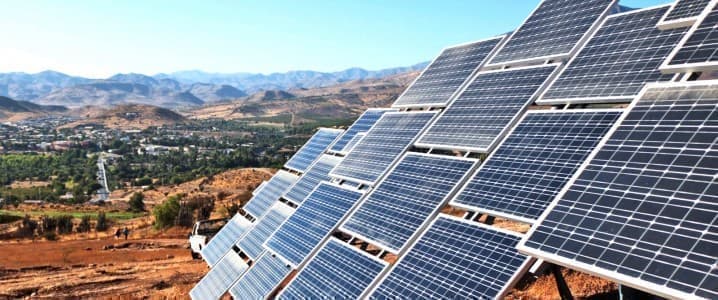The oil price crash struck right in the heart of the U.S. oil industry, Texas, where firms are curtailing production to ride out the lowest oil prices in years. If we were in normal times, the new oil crisis would have been just another bust in the boom-and-bust oil price cycle.
But these are not normal circumstances, not by a long shot. The COVID-19 pandemic and its economic repercussions have upended the plans and prospects for every industry and service sector in the top oil-producing U.S. state. And renewables are no exception.
Solar developers have canceled 2.5 gigawatts (GW) worth of projects across Texas since the oil price crash in early March, according to Bloomberg’s estimates.
The thriving solar industry in the state has hit a snag in recent months.
The Oil Bust
Three months ago, the prospects for the Texas oil industry were still bright, even though analysts had started to forecast slowing production growth going forward. The Texas economy was okay, and its economic growth and expanding oil activity warranted the construction of more power plants to meet growing electricity demand.
Solar power in a state endowed with so much land and sunshine was a perfect option. Even oil companies started to sign deals to power their drilling operations with electricity from solar and wind sources.
Then came the oil price crash as oil demand collapsed in the pandemic. Suddenly, the shale patch slashed spending and operations in response to the price rout. Layoffs began.
This would have been just another oil-bust cycle had it not been for the COVID-19 pandemic that brought the U.S. and Texas economies to their knees, threatening the financing and demand for solar power projects.
The Black Swan and the Economic Fallout in Texas
Stay-at-home orders and the temporary shutdown of restaurants, entertainment and art venues, and retailers crashed economic activity in Texas and dampened consumer and business confidence as nearly 2 million Texans applied for unemployment benefits in March and April alone.
“Activity in the service sector has been more severely affected than in manufacturing, precipitating downward pressures on wages and prices. The state’s oil and gas sector has been decimated,” Laila Assanie and Chloe Smith with the Dallas Fed wrote in a report last week.
Related: 7 Oil Countries Hit Hard By The COVID-19 Crisis
The unemployment rate in Texas hit 4.7 percent in March, up from a near-historical low of 3.5 percent in February, after the state lost 52,120 jobs in March—the largest drop since April 2009, during the financial crisis.
The jobs report for March doesn’t truly reflect the full month, and the numbers for the following months are devastating. Between March 15 and May 2, more than 1.8 million people filed for unemployment relief in Texas, according to data compiled by The Texas Tribune.
The economic recession has hit the market for financing solar power projects as well as the demand for tax credits. The economic downturn, combined with significantly reduced oil and gas operations in Texas, have started to undermine the rationale and economics for new solar power plant construction, at least in the short term.
Solar Industry Prospects in Texas
Early on in the pandemic, the key concern of the U.S. solar industry was supply chain delays and disruptions that threatened solar developers’ timelines to the point that they feared they might not meet the deadlines for projects to take full advantage of tax credits.
Later on, shelter-in-place and stay-at-home orders, challenges in permitting processes, and tightening tax equity markets have dramatically changed the outlook for the U.S. solar industry, the Solar Energy Industries Association (SEIA) says.
Through June of 2020, the U.S. solar industry will employ 188,000 workers, rather than the 302,000 employees originally forecasted – a 38-percent decline. The job losses would negate five years of solar industry growth, pushing the workforce back to a level not seen since 2014, SEIA says.
Related: The Oil Crisis Puts The Entire U.S. Economy At Risk
Texas, America’s second solar state in 2019 after California, has seen its electricity consumption grow in lockstep with its economic growth—growth partially fueled by the oil and gas industry in the past three years.
As of Q4 2019, SEIA was saying that “Texas is poised to become a nationwide leader in solar energy, with more than 4 GW of capacity expected to be installed over the next 5 years, with appropriate state policy that removes market barriers and recognizes solar’s benefits.”
But the coronavirus-driven economic slump in the state added to the oil crisis to upend Texas’ solar power prospects.
“Texas used to be very lucrative,” BloombergNEF solar analyst Tara Narayanan told Bloomberg in an interview. “Now it’s collapsing.”
For example, a sizeable utility-scale developer told SEIA’s COVID-19 impact survey that it had a shovel-ready $109-million project in Texas that would employ 550 workers and pump millions of dollars into the local economy.
“That project is now on hold because tax equity financing is drying up.”
Curt Morgan, president and CEO at Texas-based Vistra Energy, said on the Q1 earnings call last week about the ERCOT market in Texas that “we are already seeing evidence that renewable development is slowing for projects that were slated to come online in 2021 and beyond.”
By Tsvetana Paraskova for Oilprice.com
More Top Reads From Oilprice.com:
- Has Demand For Oil Already Peaked?
- Oil Prices Jump On Surprise Crude Inventory Draw
- Are Venezuelan Oil Exports Poised For A Comeback?


















